
Tree in habitat, Emery County, Utah [Jeff Bisbee, 2014.09].
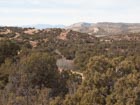
Piñon-juniper woodland is the characteristic forest formation throughout the interior western U.S. The most common species mix is Pinus monophylla and Juniperus osteosperma, here seen about 150 km west of Flagstaff, Arizona [C. J. Earle, 2012.12.23].
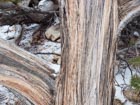
Bark on a tree about 30 cm diameter, Grand Canyon, Arizona [C. J. Earle, 2012.12.24].
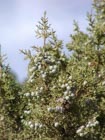
Cones in the crown of a tree in the southern Ruby Mountains of Nevada [C. J. Earle, 2001.09.25].
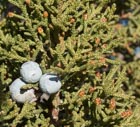
Foliage, mature seed cones, and pollen cones during the winter before maturity, on a tree in the New York Mountains, California [C. J. Earle, 2012.12.21].
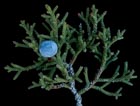
Detail of twig, foliage, and seed cone for a tree in the New York Mountains, California [C. J. Earle, 2012.12.21].
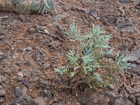
Seedling in a stand within Grand Canyon-Parashant National Monument, Arizona [C. J. Earle, 2016.05.02].

This tree near Spooky Gulch, Utah was struck by lightning and partially burned, but survived [C. J. Earle, 2016.05.07].
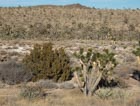
These trees in the Mohave Desert south of the New York Mountains are growing with the Joshua tree, Yucca brevifolia. This is the hottest, driest habitat inhabited by J. osteosperma [C. J. Earle, 2012.12.21].
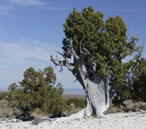
Tree in a stand near Wells, Nevada. Tree is about 1.3 m tall and has a strip-bark habit; the only surviving live bark on the trunk is hidden from the camera, on the other side of the tree [C. J. Earle, 2001.09.28].
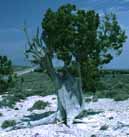
The same tree, photographed 16 years earlier [C. J. Earle, 1985.07].
>
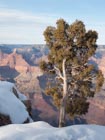
A tree growing at the south rim of the Grand Canyon [C. J. Earle, 2012.12.23].

Juniperus osteosperma
(Torrey) Little 1948
Common names
Utah juniper, sabina, cedro (Elmore and Janish 1976), desert cedar (Peattie 1950), sabina morena (Adams 1993).
Taxonomic notes
Syn: J. tetragona Schlechtendal var. osteosperma Torrey 1857; J. californica Carrière var. utahensis Engelmann; Sabina osteosperma (Torrey) Antoine; S. utahensis (Engelmann) Rydberg (Adams 1993), J. utahensis (Silba 1986). Vasek (1966) first reported evidence hybrids with J. occidentalis in northwestern Nevada, a finding that was confirmed by Terry (2010) using a rangewide analysis of certain cpDNA haplotypes, as well as a variety of morphometrics. Note that in Juniperus, the pollen parent provides chloroplast DNA, so this technique would only identify introgression of J. osteosperma by J. occidentalis; however, no authors have identified evidence of J. osteosperma introgression to J. occidentalis populations.
Description
Monoecious evergreen shrubs or trees to 12 m tall and 100 cm diameter, often with low forking trunks or multiple stems, and a rounded to irregular crown of spreading, ascending, often contorted branches. Bark on mature trees fibrous, exfoliating in long strips, pale reddish brown weathering to pale gray. Foliage primarily clumped near ends of branches; twigs rounded to quadrangular, to 3 cm long and 2.5 mm thick, covered with scale leaves in alternate whorls of 2 or 3 (3 on thick twigs, 2 on slender ones). Leaves include both whip and scale leaves. Scale leaves closely appressed, keeled, 1.5-3.5 × 1-2.5 mm, ovoid-rhombic, margins minutely denticulate (hand lens 20X or better needed), not or minimally overlapping, acute to obtuse, stomata abaxial in 2 tapering bands and near leaf base; glands central, inconspicuous, usually inactive; pale or yellow-green with whitish wax. Whip leaves 3-5 mm long, also with an abaxial gland that is active on a minority of the leaves. Pollen cones terminal, numerous, on short twigs, subglobose to ovoid, 3-4.5 × 2-2.5 mm, of 12-16 decussate microsporophylls. Seed cones terminal on short twigs, growing in 2 seasons, globose to ovoid, 7-13 × 6-12 mm, pulpy or fibrous, variably resinous, light brown but very glaucous, and dry and hard at maturity; comprised of 4-6 fused bract-scale complexes; on mature cones the bracts protrude from crescent ridges. Seeds 1 or 2 per cone, subglobose, 4-10 mm diameter, shallowly grooved, light brown (Adams 1993, Farjon 2010).
Similar species: J. scopulorum has similar range but is generally found at higher elevations. It is dioecious, usually single-stemmed, generally a darker (sometimes glaucous) green, typically has pliable and drooping leaf tips, and the leaf margins are entire at 20X magnification. The closely related taxa J. californica, J. grandis, and J. occidentalis, were distinguished by Vasek (1966) as follows: J. grandis is dioecious (95% of plants), mature trees are generally single-stemmed and quite large (average 8 m tall), and has reddish-brown bark. J. occidentalis is monoecious or dioecious (50% of plants), mature trees are generally single-stemmed and large for a juniper (average 7 m tall), and has brownish bark. J. osteosperma is monoecious (90% of plants), trees are generally multi-stemmed or forking low, mature trees average 4 m tall, bark is typically pale gray-brown weathering ashy white, and it is the only species of the group that bears no active glands on scale leaves. J. californica is a dioecious (98% of plants) low-forking or multistemmed shrub averaging 3 m tall at maturity with gray bark. Plants in northwestern Nevada often show characters intermediate between J. occidentalis and J. osteosperma, and plants in eastern Plumas and Sierra counties of California often show characters intermediate between J. grandis and J. osteosperma. The other potential hybrids are of extremely limited occurrence. Hybrid morphology was also studied by Terry (2010), who found most hybrid characters to be intermediate between J. occidentalis and J. osteosperma, including number of stems, tree height, proportion of visible glands, proportion of glands with visible exudate, cone size, seed size, and number of seeds per cone.
Distribution and Ecology
USA: Arizona, California, Colorado, Idaho, Montana, New Mexico, Nevada, Utah and Wyoming at 1300-2600 m elvation on dry, rocky soils and slopes. It is the dominant juniper of Utah (Adams 1993). See also Thompson et al. (1999). Hardy to Zone 5 (cold hardiness limit between -28.8°C and -23.3°C) (Bannister and Neuner 2001).
Distribution of the primary serrate-leaf-margin Juniperus taxa of western North America; J. osteosperma shown in green. Green discs show collection sites in northwestern Nevada where Terry (2010) demonstrated introgression of J. osteosperma by J. occidentalis cpDNA haplotypes. Note that at these sites, good specimens of both parent species were identified, as well as hybrid individuals. Click on any marker for more information and a link to the source.
J. osteosperma predominately occurs in areas with 305 to 457 mm of annual precipitation. Summers are hot and dry; winters are cold and wet, with much precipitation falling as snow. The species also occurs in areas of summer monsoonal precipitation. Predominate substrates are alluvial fans and dry, rocky hillsides with shallow, alkaline soils. J. osteosperma is a dominant species in a variety of habitat types, generally including pinyon-juniper woodlands, sagebrush (Artemisia spp.) grassland, and shrub-steppe habitat types. Common associates include the tree Pinus monophylla and the shrubs Amelanchier alnifolia, Arctostaphylos spp., Artemisia arbuscula, A. nova, A. tridentata, Ceanothus greggii, Cercocarpus ledifolius, C. montanus, Chrysothamnus viscidiflorus, Coleogyne ramosissima, Ephedra spp., Fallugia paradoxa, Fremontodendron californicum, Garrya spp., Gutierrezia spp., Juniperus californica, Prunus fasciculata, Purshia stansburyana, P. tridentata, Quercus spp., Rhus trilobata, Symphoricarpos longiflorus, Tetradymia spp., and Yucca brevifolia. Common grasses include Achnatherum hymenoides, A. thurberiana, Bouteloua gracilis, Bromus tectorum, Elymus elymoides, Festuca ovina, Hesperostipa comata, Hilaria jamesii, Koeleria macrantha, Pascopyrum smithii, Pseudoroegneria spicata, and P. secunda. The seed cones provide forage for jackrabbits (Lepus spp.), coyotes (Canis latrans), and many kinds of birds, though wildlife seldom graze the foliage (Zlatnik 1999).
Cupressaceae in general form a vesicular-arbuscular mycorrhiza. In J. osteosperma the fungal symbiont has been identified as Glomus fasciculatum; the same investigation also found limited symbiosis with an ectomycorrhiza, which was not identified (Reinsvold and Reeves 1986).
Relatively few pests and pathogens afflict J. osteosperma. It sometimes hosts the mistletoe Phoradendron juniperinum, and has several fungal pathogens, including several rusts (Gymnosporangium spp., which manifest as witches' brooms) and several rot fungi (Bunderson et al. 1986). Overall, though, the most common agent of mortality is fire (Anderegg et al. 2015). The species generally has low resistance to fire, with saplings and individuals experiencing crown scorch at highest risk of mortality. However, many stands have relatively low vulnerability to fire due to low fuel loadings associated with low site productivity (Zlatnik 1999).
Remarkable Specimens
American Forests (2021) rated the "champion" as a tree near Mojave, Arizona with dbh 164 cm, height 12.2 m, and crown spread 16.1 m (last measured in 2020). Larger diameters have been found in the past; in 1996, the largest tree was in Duchesne County, Utah and had dbh 221 cm, height 9 m, and crown spread 8 m. I know of no age data, but based on observations, I am fairly confident that it occasionally exceeds 1,000 years.
Ethnobotany
The wood was used by Great Basin native tribes to make bow staves (Wilke 1988). See also Lanner (1983).
Preliminary studies in dendrochronology found a high frequency of absent rings and poor circuit uniformity (that is, a ring varies in width around the circumference of the tree). Consequently, the species has been little used.
Observations
Common and easily seen at Arches, Canyonlands, Capitol Reef, Bryce Canyon, and Zion National Parks in Utah, and Great Basin National Park in Nevada. In fact, it is difficult to travel in the Great Basin or Colorado Plateau without seeing landscapes covered with this tree, usually in pure stands or accompanied only by Pinus monophylla.
Remarks
The epithet osteosperma means "bony seed."
Citations
Adams, Robert P. 1993. Juniperus. Flora of North America Editorial Committee (eds.): Flora of North America North of Mexico, Vol. 2. Oxford University Press. This document is available online. Go to http://www.efloras.org, click on "Flora of North America," and search for "Juniperus."
American Forests 1996. The 1996-1997 National Register of Big Trees. Washington, DC: American Forests.
American Forests 2021. 2021 National Register of Champion Trees. Washington, DC: American Forests.
Anderegg, William R. L., Jeffrey A. Hicke, Rosie A. Fisher, Craig D. Allen, Juliann Aukema, Barbara Bentz, Sharon Hood, Jeremy W. Lichstein, Alison K. Macalady, Nate McDowell, Yude Pan, Kenneth Raffa, Anna Sala, John D. Shaw, Nathan L. Stephenson, Christina Tague, and Melanie Zeppel. 2015. Tree mortality from drought, insects, and their interactions in a changing climate. New Phytologist 208(3):674–683.
Bunderson, E. D., D. J. Weber, and D. L. Nelson. 1986. Diseases associated with Juniperus osteosperma and a model for predicting their occurrence with environmental site factors. The Great Basin Naturalist 46(3):427–40.
Little, E. L., Jr. 1948. Older names for two western species of Juniperus. Leafl. W. Bot. 5: 125-132 (p. 125).
Reinsvold, R. J. and F. B. Reeves 1986. The mycorrhizae of Juniperus osteosperma: identity of the vesicular-arbuscular
mycorrhizal symbiont, and resynthesis of VA mycorrhizae. Mycologia 78(1):108-113.
Terry, Randall G. 2010. Re-evaluation of morphological and chloroplast DNA variation in Juniperus osteosperma Hook. and Juniperus occidentalis (Torr.) Little (Cupressaceae) and their putative hybrids. Biochemical Systematics and Ecology 38(3):349–60.
Zlatnik, Elena. 1999. Juniperus osteosperma, in Fire Effects Information System. U.S. Department of Agriculture, Forest Service, Rocky Mountain Research Station, Fire Sciences Laboratory (Producer). https://www.fs.usda.gov /database/feis/plants/tree/junost/all.html, accessed 2023.08.17.
See also
Farjon (2005) provides a detailed account, with illustrations.
Gallery
Although in some ways J. osteosperma is just a backdrop for the vast landscapes encompassed within its range, it can be an exceptionally photogenic tree.
|
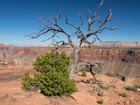
|
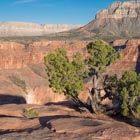
|
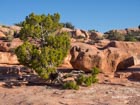
|
|
This tree at Toroweap Overlook in the Grand Canyon seems to have died back severely, likely during a drought, and is now recovering [C. J. Earle, 2016.05.03].
|
Another tree at Toroweap Overlook [C. J. Earle, 2016.05.03].
|
Another tree at Toroweap Overlook [C. J. Earle, 2016.05.03].
|
|

|
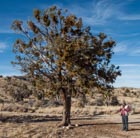
|
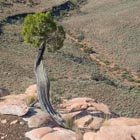
|
|
A tree in the Kolob section of Zion National Park, Utah, where it grows with with J. scopulorum and Pinus monophylla-edulis hybrids. Note mistletoe in the crown [C.J. Earle, 2015.11.23].
|
A tree in the New York Mountains of California shows a relatively unusual monopodial growth form and harbors a dense infestation of mistletoe [C.J. Earle, 2012.12.21].
|
This little tree at Toroweap Point is less than a meter tall, but may be several hundred years old [C.J. Earle, 2016.05.03].
|


















